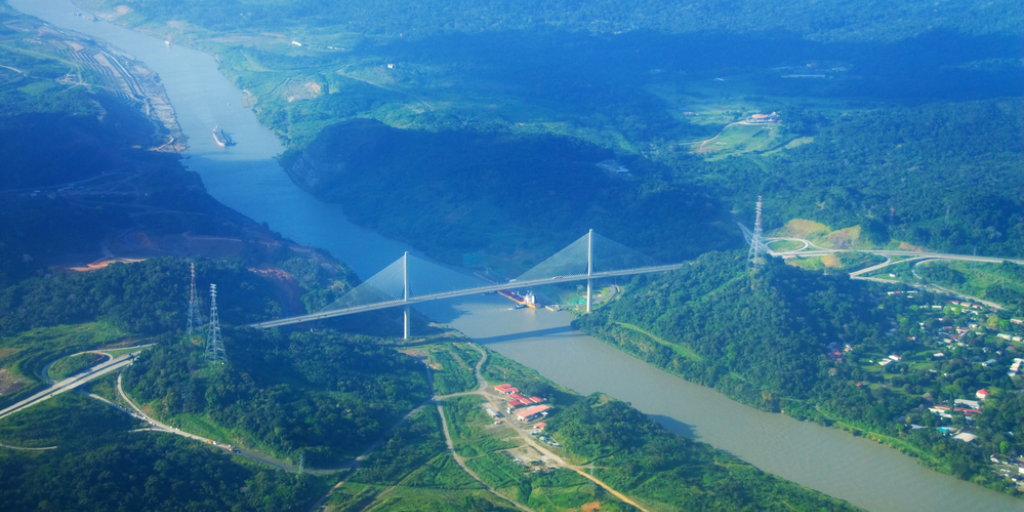You know that feeling when one lane of a two-lane highway is closed for construction, and now everyone has to get through just one lane? Now picture that level of frustration, only in the Panama Canal
Lesson summary
Hi again, it’s Jeff, back in your earbuds for another episode of Plain English. This one is number 634, so that means JR has uploaded the transcript and the full lesson resources to PlainEnglish.com/634.
As you know, at Plain English we use stories to help you upgrade your English. And the stories are about the world—what’s going on, what’s happening. And today’s story is about the Panama Canal. This is the canal that connects Asia to the east coasts of North and South America.
But there is a problem right now, and that is a drought in Panama. And the drought is limiting the number of ships that can pass through the canal. That’s today’s story. In the second half of the lesson, we talk about an English expression. And today that expression is “in place.” It’s a really good one; I’m surprised we haven’t done it yet. “In place” is the expression. And we have a quote of the week.
Let’s get started.
Drought in Panama complicates canal traffic
Whoever designed the current arrangement of the continents didn’t have world trade in mind.
Prior to 1914, ships sailing from Asia to the east coasts of North or South America had to take a circuitous route. They had to go south in the Pacific Ocean; around Cape Horn, the southernmost tip of South America; and then back north along the Atlantic coast. Not only is that route indirect, but it’s also dangerous.
But then the Panama Canal opened, allowing a shortcut . And since then, it has been a key to world trade. Today , about six percent of all oceangoing commerce passes through the canal, which has been modernized and expanded many times.
On a good day, the canal can accommodate between 38 and 40 ships. But lately , the days have not been that good. That’s because Panama is suffering a drought. On December 1, the Panama Canal Authority limited the number of crossings to 24. Starting in February, that will go down to just 18—less than half its normal capacity.
Why would a drought affect a canal? The canal operates using a system of locks. These are the enclosed chambers that raise and lower the water level so that ships can go from one body of water to another. The water in the Panama Canal locks is fresh water—a lot of fresh water. The Panama Canal uses twice as much water in a day as does the city of New York. And the source of all that water is a series of man-made reservoirs.
You know where this is going.
Panama is a rainy place. It’s one of the wettest countries in the world. The rainy season is between May and December. And in a normal year, the rainfall refills the reservoirs, so that there’s enough fresh water to power the canal for the full year.
But this is not a normal year. The weather system that dumps rain on Panama is stuck to the south, so that Lake Gatun and other reservoirs have not refilled this year—and the rainy season is almost over. So the Panama Canal Authority is taking drastic measures to reduce the use of water in transit.
In addition to limiting the traffic, the Authority is also limiting the weight of the ships that pass through. Lighter ships cause less water displacement in the locks. But they can also carry less merchandise.
All this means that shippers will face higher transit costs. Some ships will simply not get one of the limited slots to cross the canal. Shippers will have to re-route their ships around the Cape Horn, adding time and expense to the journey. It’s also possible to cross Panama by land: unload the containers on the Pacific side, transport them by train, and re-load them again on another ship on the Atlantic side. But that, too, is expensive.
The higher costs will likely be passed on to the customers of the goods going through the canal. When you think of the Panama Canal today, you might think of manufactured goods coming from Asia to the Americas. But grain, liquid natural gas, cars, and more all pass through the canal—and are all likely to be more expensive now.
The Panama Canal Authority warned the new restrictions will be in place for at least nine more months, so the higher costs are here to stay—at least for a while.
I would love to see the Panama Canal one day. It’s on my bucket list . Just look at a map of the world. They carved a route across land to connect oceans! And they did it in 1914. I just think that’s amazing—probably because I don’t know much about engineering, I don’t know about physics, about a ship’s draft, displacement, all that stuff.
To me, it’s just all a complete mystery—it’s like magic. I love it. And you can visit. The most popular locks are not far from Panama City, the capital.
Quote of the Week
Here’s a quote for today. “When we are tired, we are attacked by ideas we conquered long ago.” When we are tired, we don’t always think straight. We start to doubt ourselves, we have negative thoughts. So keep this in mind from the philosopher Friedrich Nietzsche: “When we are tired, we are attacked by ideas we conquered long ago.”
Learn English the way it’s really spoken

